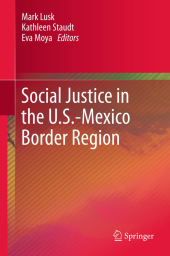 Neuerscheinungen 2014Stand: 2020-02-01 |
Schnellsuche
ISBN/Stichwort/Autor
|
Herderstraße 10
10625 Berlin
Tel.: 030 315 714 16
Fax 030 315 714 14
info@buchspektrum.de |

Mark Lusk, Eva Moya, Kathleen Staudt
(Beteiligte)
Social Justice in the U.S.-Mexico Border Region
Herausgegeben von Lusk, Mark; Staudt, Kathleen; Moya, Eva
2012. 2014. xii, 288 S. 235 mm
Verlag/Jahr: SPRINGER NETHERLANDS; SPRINGER 2014
ISBN: 9400793707 (9400793707)
Neue ISBN: 978-9400793705 (9789400793705)
Preis und Lieferzeit: Bitte klicken
This book provides a better understanding of life in this region. It examines a variety of examples of injustice and proposes a pathway to development.
The U.S.-Mexico Border Region is among the poorest geographical areas in the United States. The region has been long characterized by dual development, poor infrastructure, weak schools, health disparities and low-wage employment. More recently, the region has been affected by the violence associated with a drug and crime war in Mexico. The premise of this book is that the U.S.-Mexico Border Region is subject to systematic oppression and that the so-called social pathologies that we see in the region are by-products of social and economic injustice in the form of labor exploitation, environmental racism, immigration militarism, institutional sexism and discrimination, health inequities, a political economy based on low-wage labor, and the globalization of labor and capital. The chapters address a variety of examples of injustice in the areas of environment, health disparity, migration unemployment, citizenship, women and gender violence, mental health, and drug violence. The book proposes a pathway to development.
Section I - Introduction and Conceptual Framework.- Chapter 1. Social Justice in the U.S. - Mexico Border Region: A Conceptual Framework; Mark Lusk, Kathleen Staudt, & Eva Moya.- Section II - Critical Perspectives on the Border Region.- Chapter 2. Political Economy and Social Justice in the US Mexico Border Region; Josiah Heyman.- Chapter 3. The Violence of Citizenship on the U.S.-Mexico Border: How Citizenship Creates Exclusion and Inclusion; Tony Payan.- 4. Women, Gender and Violence in La Frontera; Kathleen Staudt.- Chapter 5. A Theological Perspective on Social Justice in the U.S. - Mexico Border Region; John Stowe.- Section III - Problems and Opportunities on the U.S. - Mexico Border .- Chapter 6. Housing, Colonias and Social Justice on the Border; Guillermina Gina Nú¤ez-Mchiri.- Chapter 7. Achieving Health Equity and Social Justice; Nuria Homedes.- Chapter 8. Mental Health Disparities and Social Justice; Griselda Villalobos & Arthur Islas.- Chapter 9. Border Health: Health Inequities, Social Determinants and the Case of Tuberculosis and HIV; Eva Moya, Oralia Loza& Mark Lusk.- Chapter 10. Environmental Injustice in the U.S. - Mexico Border Region; Sarah E. Grineski & Patricia Juarez.- Chapter 11. Migration and Discrimination: The Social Condition of Mexican Migrants who are Repatriated to Ciudad Juárez; Irasema Coronado & Héctor Padilla.- Section IV - Moving Forward - Steps in Achieving Border Justice.- Chapter 12. Education Policies: Standardized Testing, English-Language Learners, and Border Futures; Pauline Dow & Kathleen Staudt.-Chapter 13. Border Challenges and Ethnic Struggles for Social Justice: Latina/o Communities under Siege; Rosalía Solórzano Torres.- Chapter 14. Social Justice in the U.S. - Mexico Border Region: Implications for Policy and Practice; Mark Lusk, Kathleen Staudt & Eva Moya.- Afterword ; Monsignor Arturo Ba¤uelas.-


